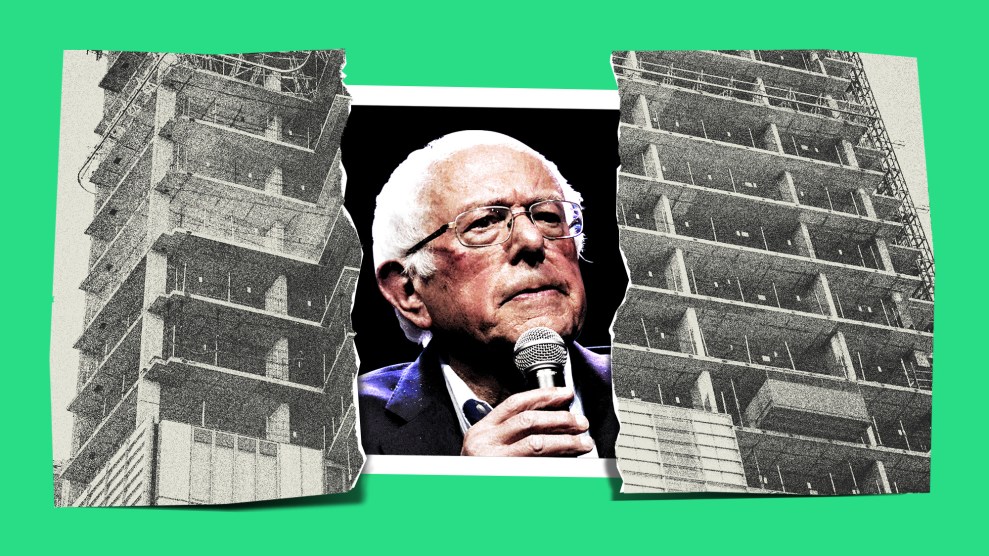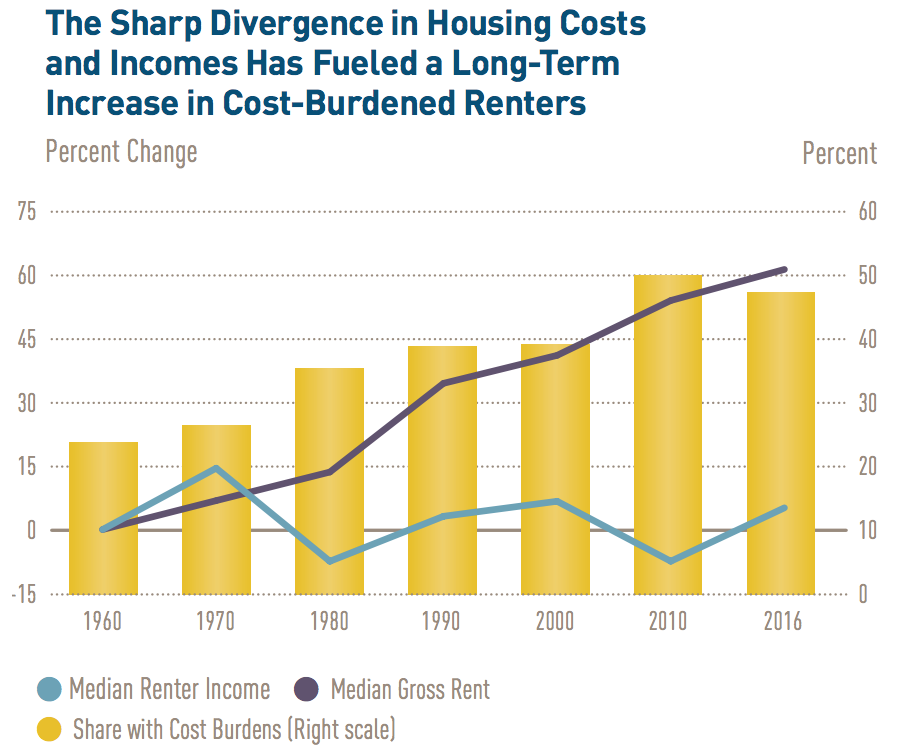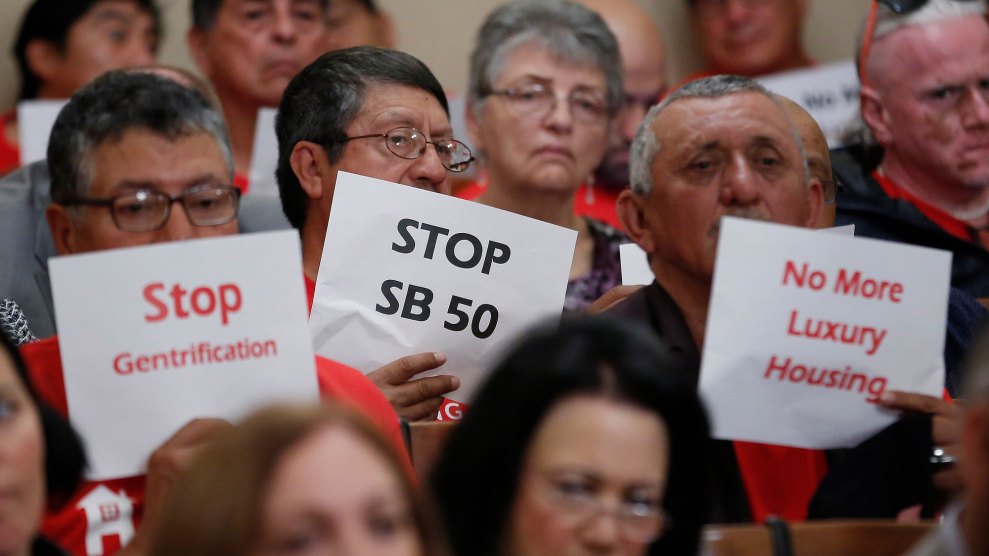
Mother Jones illustration; Bastiaan Slabbers/NurPhoto/Zuma; Getty
In October 2017, David Sullivan read a surprising story in the paper: Bernie Sanders was holding a press conference to announce his endorsements for city council candidates in the upcoming elections in Sullivan’s hometown of Cambridge, Massachusetts, and neighboring Somerville. “Which shocked me, because I didn’t know Bernie knew anything about local politics,” says Sullivan, who himself was elected to Cambridge’s council five times in the 1980s. “And it turned out, he didn’t know anything about local politics.”
Sullivan was a member of Our Revolution, the political nonprofit Sanders had founded in 2016, and of the Democratic Socialists of America, which had endorsed Sanders for president that year and would do so again in the 2020 Democratic primary.* But the voting rights lawyer was also a volunteer with A Better Cambridge, a nonprofit that supports housing production and tenant protections and had recently made its own endorsements in the council races. There was no overlap between the group’s selections and Sanders’ picks, who were generally much more critical of new housing development, arguing that building additional market-rate housing wouldn’t make the city more affordable.
Of the five Cambridge candidates endorsed by the Vermont senator and the local Our Revolution chapter, four won seats on the nine-member council, including one newcomer who, according to Sullivan and other members of A Better Cambridge, was little known before Sanders backed him and would almost certainly not have prevailed otherwise. The most contentious matter facing the new council was a plan known as the 100% Affordable Housing Overlay, which would promote the construction of new affordable housing by allowing developers to build slightly taller buildings than currently permitted if they kept all the units permanently affordable to low- and moderate-income renters.
The overlay proposal had strong support from housing advocates in a city with a severe shortage of affordable rentals and a progressive commitment to equity. But it required a six-vote supermajority on the council to pass. The contentious deliberations finally came to a head this month. Two of the council members endorsed by Sanders opposed the plan, citing concerns about building design, the effect on the city’s tree canopy, and the potential for substantial increases in residential density in some areas. With the support of just five members, the plan was tabled.
“I’m convinced that if Bernie hadn’t gotten involved two years ago, we would have had the six votes,” says Sullivan. “So it’s a really awful thing he did.”
In Cambridge, as in liberal urban areas throughout the country, the deepest political fault line is generally not between the left and right, so vanishingly small is the turf claimed by conservatives. Instead, the line tends to divide supporters of greater housing density and its opponents. The “not in my backyard” (NIMBY) crew argues against policy changes that will allow more density, sometimes citing concerns about aesthetics, traffic, and parking, and sometimes arguing that an increase in market-rate housing won’t actually help lower-income residents. The “yes in my backyard” (YIMBY) crowd counters that there’s such an imbalance between supply and demand in the country’s thriving metropolitan areas that an overall increase in housing is needed—that the addition of a modest number of government-subsidized units for low-income residents won’t change the market forces that are making these areas unaffordable for the masses.
That fault line also runs through the field of progressive Democratic presidential candidates, though it hasn’t always been as obvious. Last week, Sanders became the latest candidate to release an ambitious housing plan. Like his rivals, Sanders pledged tenant protections and huge public investments in affordable housing. And, like his rivals, Sanders proposed federal incentives to induce cities and towns to loosen zoning restrictive codes and allow more homes to be built on the private market—similar to what Cambridge’s overlay would have done, but on a much broader scale and for housing across the income spectrum.
But on the campaign trail, Sanders has expressed skepticism of private housing development. At the NAACP presidential candidate forum in July, Sanders’ chief rival for the left-leaning bloc of Democratic voters, Sen. Elizabeth Warren (D-Mass.), told the crowd, “I have a plan to build about 3.2 million new housing units in this country.” Sanders, by contrast, thundered, “We’re gonna tell the developers: You just cannot come in and build expensive condominiums!”
All of the Democrats agree on the need to shore up affordable housing, which has dwindled to crisis levels in high-demand metropolitan areas across the country, and to strengthen government-backed housing. The divisions arise over the role of the private housing market: Many housing advocates argue that there’s no conceivable way for the government to build enough housing to bring supply in line with demand in America’s most expensive areas. So absent those developers and their condos (or whatever types of housing the market demands), the math simply doesn’t add up.
The distrust of private housing developers among some liberals can lead to strange alliances. “The unfortunate effect of endorsing the people that Bernie Sanders endorsed,” says Eugenia Schraa, executive director of A Better Cambridge Action Fund, the political action committee affiliated with A Better Cambridge, “is that it helped people who claimed to be progressive but who—whether purposefully or not—end up allying with the most conservative faction of people in Cambridge, who tend to be wealthier, whiter homeowners, and enact policies that keep people out, including immigrants, young people, and newcomers of any kind.”
One clue to the genesis of Sanders’ approach to housing appeared during the most recent Democratic presidential debate, when the candidates were asked about the role of resilience in their lives and careers. “Resilience, to me,” Sanders responded, “means growing up in a rent-controlled apartment in Brooklyn, New York.”
If there’s a throughline in Sanders’ career when it comes to housing, it’s the powerful belief in the need for the government to protect Americans of modest means from predatory developers, landlords, and market forces. “It is not acceptable that, in communities throughout the country, wealthy developers are gentrifying neighborhoods and forcing working families out of the homes and apartments where they have lived their entire lives,” he wrote this spring in the Las Vegas Sun. Sanders’ national housing plan would not only massively expand the Section 8 rental assistance program but also cap rent increases in the private market at 3 percent (or 1.5 times the rate of inflation, if that’s higher).
Most housing advocates support this type of expansion of the government’s role in housing (though most economists, even progressive ones, are critical of rent control for its lack of means-testing and its tendency to reduce the supply of available housing). But no government effort will be enough, many of them say, without more market-rate housing, too. And it’s increasingly clear that cities aren’t going to add enough density on their own without a strong nudge from the state or federal governments—it’s just too easy for them to object to new development because of concerns about traffic or sunlight or “neighborhood character” and the enduring hope that housing gets built somewhere else.
Sanders’ national housing plan does call for zoning changes to encourage more housing. But because housing issues are overwhelmingly decided at the local level, his endorsements in local races may ultimately prove more consequential. His intervention in the Cambridge council race has probably changed the future of housing there more than he would be able to do as president. In recent years, as he has become a national icon of the left, Sanders has quietly exerted his greatest influence on local housing policies by throwing his weight behind candidates opposed to market-rate housing growth—not just in Cambridge but also in liberal enclaves in California, where the housing crisis is the worst in the nation.
Sanders has had a complicated relationship with the private housing market throughout his nearly four decades in elected office, starting with his time as mayor of Burlington, Vermont, in the 1980s. His first political victory was built on a slogan: “Burlington is not for sale.” His target was a plan to redevelop the city’s waterfront with a hotel and 240 high-rise condos. In the flourishing college town, gentrification was a source of concern, says Garrison Nelson, a retired University of Vermont political scientist who has known Sanders for 40 years, and working-class residents were receptive to Sanders’ message. He won the 1981 mayor’s race by 10 votes. Housing-market pressures, Nelson says, tipped the balance.
In his memoir, Sanders would write about battling the real estate industry and the landlord association to push for rent control, kill the waterfront plan, and create a community land trust to preserve affordable housing. “Our campaign reminded the people of Burlington that the incumbent mayor and his local Democratic machine were in cahoots with the downtown business community and irresponsible ‘pro-growth’ forces,” he boasted. In reality, say people who worked with him then, Sanders’ relationship with developers wasn’t quite so clear-cut.
Once in office, Sanders took a pragmatic turn. He backed a second waterfront development plan that featured its own high-end condos, drawing substantial criticism from the left. (The Burlington anarchist Murray Bookchin wrote in the Socialist Review in 1986 that Sanders was a “centralist” running a “civic oligarchy.”) The city’s wealthiest areas supported the bond issue for the development, but the working-class wards that had backed Sanders’ mayoral campaign voted it down. Eventually, a different waterfront redevelopment plan was approved.

The push for rent control began before Sanders’ mayoralty, and “he kind of endorsed rent control but not with any passion,” says Greg Guma, a longtime Burlington writer and activist who has known Sanders since 1971. In the face of a more energetic campaign against rent control from city landlords, the measure was defeated in a citywide vote. “As soon as he saw the outcome, he backed away from it,” Guma says. “Rent control was never touched again for the rest of his term, for eight years.”
Sanders had more success with the community land trust, pioneering a structure in which a nonprofit takes control of land and imposes affordability requirements on all houses built there. Burlington’s land trust, which was established under Sanders in 1984 and later merged with another regional trust, remains the largest in the country and a national model—it now accounts for more than 7 percent of the city’s housing and has increased housing affordability and lowered homeowner foreclosure. (Some land trusts that have followed, including the second-biggest one, in Boston, have come under criticism for creating single-family homes and impeding the development of more housing units.)
Sanders ended up working closely with private developers on projects like the waterfront; one major local developer who was an early Sanders foil became a close friend and a regular partner. But it was useful to Sanders’ political narrative to cast them as antagonists, even after he’d begun working with them. “There’s always a villain,” Guma says of Sanders’ messaging to his supporters. “They’re always out to get him.”
If Sanders’ war on private housing development in Burlington was largely rhetorical, it would later become a lot more real—and nowhere more so than in the place with the most dire housing shortage in the country.
Between 2007 and 2014, as Silicon Valley boomed and workers flocked to the San Francisco Bay Area, the region granted permits for half as many housing units as it needed to keep up with population growth, due to restrictive local zoning codes. Home prices soared, San Francisco became the most expensive rental market in the country, homeownership became absurdly out of reach for middle-class residents across the region, and a homelessness crisis took hold. Alongside the latent NIMBYism that provoked the housing shortage, a YIMBY movement arose, and Scott Wiener became its public face.
In the spring of 2016, Wiener, a member of the San Francisco Board of Supervisors, was cruising to victory in his race for California State Senate. He had a huge fundraising lead and the endorsements of the state Democratic Party and the outgoing senator. Then he learned from a staffer that Sanders was about to endorse his Board of Supervisors colleague Jane Kim in the primary.
“It was 15 days before the primary, and at the peak of Bernie’s popularity,” Wiener says. “And I remember just thinking to myself, ‘Hold on, here it comes!’”
The race changed immediately. Sanders sent an email to supporters, asking to donate to Kim, describing her as “a civil rights attorney who’s fought for affordable housing and fair wages in her city.” Money poured in. “Thirty days before the primary, there was a poll that had me up 10 points,” Wiener says. “Over the final two weeks of the primary campaign, he campaigned with her, I believe, five times in San Francisco. He was with her constantly. And she edged me out in the primary.” (Kim says Sanders’ endorsement “had an impact” but also credits an ad she released for closing the gap with Wiener.)
Wiener went on to win the runoff election against Kim that November by two points, but Sanders’ endorsement nearly changed the face of the housing debate in California, whose shortage of homes is estimated as high as 3 or 4 million. In the Senate, Wiener introduced two landmark bills that would have allowed taller buildings around major transit stops throughout the state, barring cities and counties from preventing this denser development through restricting zoning codes. The affordable housing requirements were modest, but the idea was to slow the escalation of overall housing costs by bringing supply closer to demand. The measures launched Wiener to the forefront of the nationwide debate over housing affordability, though both of his proposals ultimately failed after contentious fights over density and local autonomy.
Kim opposed Wiener’s legislation because, she explains, “I do support mandates from the state on housing production goals, but allowing localities to determine where they’re built.” Wiener also criticized her for backing a moratorium on new housing in San Francisco’s rapidly gentrifying Mission district, a move she says was intended to give the city time to study ways to slow displacement of Latinos from the neighborhood. In her 2016 campaign, she said, “What we don’t want is to increase the supply of unaffordable housing,” suggesting that her goal was not growth in the city’s overall housing stock but projects guaranteed to create affordable homes. (In May, Sanders named Kim his regional campaign director for the Bay Area.)
Kim was one of four Bay Area candidates endorsed in 2016 by Sanders or his organizing group Our Revolution who came under criticism from YIMBY activists for their housing stances. Brian Hanlon, president of California YIMBY, was surprised when Sanders made his 2016 endorsements. “My first reaction was, does Bernie understand the local politics here?” he says. “He was supporting people who were identified as progressive, but many of these people had been opposing homebuilding, including affordable homebuilding, for years.”
For instance, for the San Francisco Board of Supervisors, Our Revolution endorsed Dean Preston over future mayor London Breed. Preston, considered the more liberal candidate, had criticized Breed for legislation she had proposed to allow greater density in the city without imposing new affordability requirements. He believes that market-rate housing isn’t helping in places like San Francisco, because “market-rate housing is completely unaffordable to the working class.” There are places, he says, where more overall density is needed, like exclusive suburbs, but not gentrifying cities where new market construction tends to be higher-end. He’s deeply critical of the YIMBY movement, saying, “Essentially the YIMBY view is that anyone who does not embrace unlimited housing, including market-rate, is anti-housing.”
Across the San Francisco Bay, in the 2016 Berkeley mayor’s race, Sanders endorsed Jesse Arreguín, another progressive who was sometimes critical of greater housing density. Berkeley is about as lefty as American cities come—Trump’s 3.2 percent of the vote there in November 2016 put him in third place, behind Jill Stein’s 4.6 percent—but it can have a stubborn anti-development streak in the face of the region’s severe housing shortage, a vestige of opposition to the destructive urban renewal plans of the 1950s and ’60s. On the city council, Arreguín had authored a 2014 measure that opponents argued would gut Berkeley’s downtown plan, which promoted density and housing, by imposing new restrictions on development. His aim, he said, wasn’t to impede density but to require more community benefits from developers who would take advantage of the new policy. Since many of his constituents lived near downtown and opposed increased density, he felt he needed to represent them. City voters rejected the measure by more than a 2-1 margin.
Laurie Capitelli, a council member and the outgoing Democratic mayor’s handpicked successor, was seen as the frontrunner in the mayor’s race prior to Sanders’ endorsement of Arreguín. “Bernie had a lot of supporters in Berkeley,” Capitelli says. His door-to-door canvassers reported that residents were bringing up Sanders’ endorsement in their decision-making on the mayoral race. Arreguín won with 47 percent of the vote.
“We’re convinced that the mayor’s race in Berkeley was tipped by Bernie’s endorsement,” says Matthew Lewis, communications director for the nonprofit California YIMBY, “and not in a good way.”
Arreguín would later call Wiener’s housing bill “a declaration of war against our neighborhoods.” But his most infamous stand against housing development centered on a single residential property in Berkeley. A developer bought a dilapidated house on a large lot and planned to replace it with three smaller homes. The plan was allowed under the city’s zoning, but Arreguín, still on the city council in 2016, voted to reject the building permit anyway, citing “out-of-scale development that will compromise the quality of life and character of our neighborhoods.” The state’s Housing Accountability Act requires cities to approve projects that meet the zoning code, so a judge forced the city to approve the permit. The next year, as mayor, Arreguín rejected the plans again, this time by denying a demolition permit. Again, a judge overruled him.
Arreguín says he didn’t oppose the project itself but simply wanted to challenge the parameters of the Housing Accountability Act to try to exert more local control. Asked about his opposition to the project while on the city council, before the Act had come into play, he says, “My recollection was that there was pretty strong neighborhood opposition to the project.” But he says that since becoming mayor, he has grown more supportive of housing density, given the city’s dire need for more housing, and that Berkeley is permitting and building more housing than it has in decades. “I will admit, my perspective on land use has changed, from what it was when I was representing downtown,” he says. “As mayor, I have to represent the entire city.”
In 2018, Sanders again waded into Berkeley politics. He made a single endorsement in California’s election for state legislature, in the race to represent Berkeley and the surrounding area. Politically, it made sense for Sanders to oppose Buffy Wicks, who had served as California state director for Hillary Clinton’s campaign. But again, the race turned on housing. Wicks declared, “We have a housing crisis,” and she promoted an “all-of-the-above approach” to remedying it. Jovanka Beckles, Sanders’ pick, who had voted against or abstained on several housing projects on the Richmond council, countered, “We don’t suffer from a housing shortage crisis. We’re suffering from a housing affordability crisis.” (Beckles says she opposed one project because it was located too close to an oil refinery and another because the developer “had unscrupulous practices.” She reiterates, “Right now there is no shortage of luxury housing…We have a shortage of affordable and moderate-income housing.”) Wicks ended up winning the seat.
“He’s endorsed all anti-housing people out here,” says Laura Foote, executive director of the San Francisco–based YIMBY Action.
It would be wrong to paint Sanders’ local endorsements as part of a deliberate unified strategy. Some of them were basically random: His backing of Arreguín came after a candidate for the Berkeley Rent Board allied with Arreguín happened to knock on the door of former socialist mayor Gus Newport, an old friend of Sanders from their mayoral days, while collecting campaign signatures and asked if he’d give Sanders a call. He did, and the endorsement followed. Sanders has admitted that his real interest is in national matters, not local ones, writing in his memoir about his initial run for Burlington mayor, “I knew very little about Burlington city government…In some ways, running for statewide office was easier than running for mayor because I was more familiar with the terrain of national and statewide politics.”
To the extent that Sanders was delving into local issues at all, it’s likely that he made some of his endorsements on the basis of issues other than housing. But in Cambridge, at least, housing was arguably the central point of disagreement among the candidates. “On most other issues, there’s wide agreement,” says Sullivan, the former council member. “This is a very progressive city. There is no real division within city politics except over this housing and zoning issue.”
The Sanders campaign declined interview requests and did not answer a list of questions about the senator’s history on housing. A spokesperson did note in an email that the California candidates Sanders endorsed also had the backing of other liberal leaders and groups. The spokesperson added, “To be clear, Sanders housing plan DOES NOT encourage high end developers and speculation.”
Some of the candidates Sanders declined to endorse, like Wiener, don’t blame the senator for his decision, instead faulting a problematic definition of “progressive” in liberal cities. “I think it’s a deeper problem: The progressive movement has failed on housing,” says Foote. “In every deep-blue city, it is shocking to pro-housing progressives that progressives in what should be thriving cities are very anti-housing.”
All of the pro-housing organizations have had strong Sanders support among their membership. Most of A Better Cambridge’s board of directors at the time of Sanders’ endorsements voted for him in the 2016 primary. (Sullivan, despite his Democratic Socialists and Our Revolution affiliations, backed Clinton.) Wiener says most of his 2016 campaign staff supported Sanders. But Sanders’ stance on housing has prompted some housing advocates to reconsider. Nearly every advocate who commented for this story is backing Warren in the 2020 race.
“This is the Elizabeth Warren-Bernie Sanders divide,” says Foote. “The entire YIMBY movement is falling in love with Elizabeth Warren.” She says Julián Castro, the former secretary of Housing and Urban Development, who also released a sweeping housing plan early in the race, is many people’s second choice.
Jesse Kanson-Benanav, who founded A Better Cambridge in 2012 and led it until earlier this year, soured on Sanders after the Cambridge endorsements and is now backing Warren too. “Even as a 2016 Sanders supporter,” he says, “I’m not on his team this time.”
Correction: An earlier version of this article misidentified David Sullivan’s membership in Our Revolution. Sullivan is a member of the national organization.












